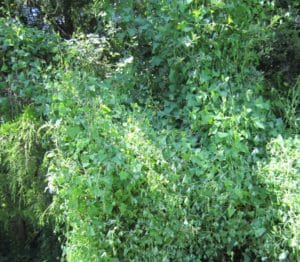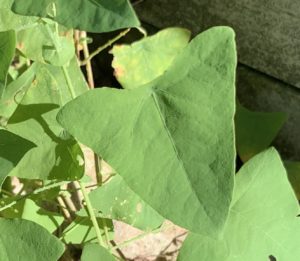Hello Fellow Readers,
Sarah of Hope, NJ, was shy about providing photos before our Landscape Review and Recommendation meeting. Primarily because she fell behind in her garden maintenance, something I share in common during the summer heat. Sarah’s Mile-a-Minute weed is especially running rampant.
“No need to be embarrassed,” I wrote back. “The purpose of my visit is to help create a strategy to attack garden projects that feels overwhelming, including the weeds.”
Mile-a-Minute weed shades other plants, killing them.
What a lovely property Sarah has with a naturalized buffer surrounding a beautiful sloping backyard. Sadly Mile-a-Minute weed (Persicaria perfoliate) is smothering much of it. It’s the first time I’ve seen such an invasion of the light green vine that grows as much as six inches a day and twenty-five feet a season. It hangs like thick draperies on trees and shrubs, which can kill them quickly as it shades its host from being able to photosynthesize. Folks compare it to the Kudzu dilemma that suffocates trees in warmer climates.
Mile-a-Minute came from transport from eastern Asia in the late 1800s to the 1930s. It arrived in our neck of the woods in nursery plants delivered to York, PA.
The almost perfect triangular leaves stand out, though the white flowers are insignificant and turn into green berries in mid-July. It’s when the berries ripen to a reflective blue hue when birds and other critters flock, which is how Mile-a-Minute spreads rapidly by way of their excrements. Each plant produces thousands of berries that can remain viable in water for nine days floating merrily down our streams.
How to remedy a Mile-a-Minute invasion
The weeds are shallow-rooted and easy to pull, which is better to do sooner than later. Otherwise, it’s hard to get to the origin of the plant, which is the case of Sarah’s invasion. However, I suggested she keep yanking with thick gloves to protect her from their prickly parts until she gets to the roots. The good news is it’s an annual. And, if you don’t allow the berries to ripen, you can stay ahead of the dilemma or, in Sarah’s case, begin to gain control of it.
While herbicides may have a place in the eradication, weeding, continually mowing, or allowing your goats and sheep to graze is the most effective. Experimental biological controls are underway, introducing a weevil (Rhinocominus latipes) that feeds on the plants.
I had to chuckle when I googled remedies of good riddance. A fellow began his video demonstration by shooting into a tree being smothered by the vine (NOT a bright idea) before he pulled it out by its roots (GREAT idea). Then he splayed out the trails of vines and sprayed the heck out of it with Round-up. (Talk about OVERKILL.) Hopefully, he wasn’t serious, as obviously, once you yank it by the roots, the plant is a goner. Just wrap it up and throw it out. If it hasn’t gone to seed, to the compost is fine. Otherwise, a brown bag in the trash is best to quarantine the berries from taking over our world. Garden Dilemmas? AskMaryStone@gmail.com and your favorite Podcast App.
Is Goldenrod Invasive? I invite you to click through to find out.
Column updated 7/28/22




